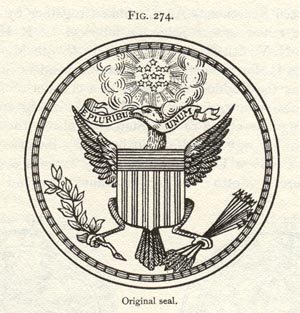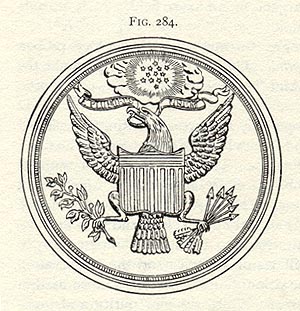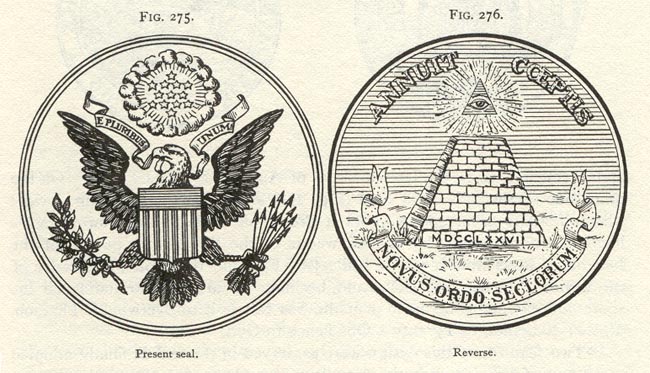
See also the booklet in PDF format from the U.S. Department of State.
The Government of the United States has its coat of arms, which were created by an Act of Congress of Jun 20, 1782:
The device for an armorial achievement, and reverse, of the great seal of the Unites States in congress assembled, is as follows:
ARMS: Paleways of 13 pieces, argent and gules; a chief, azure; the escutcheon on the breast of the American eagle displayed proper, holding in its dexter talon an olive branch, and in his sinister a bundle of 13 arrows, all proper, in his beak a scroll, inscribed with this motto: "E pluribus unum."
For the CREST: over the head of the eagle, which appears above the escutcheon, a glory, or, breaking through a cloud, proper, and surrounding 13 stars, forming a constellation argent on an azure field.
REVERSE: A pyramid unfinished. In the zenith an eye in a triangle, surrounded by a glory, proper. Over the eye theses words: "Annuit coeptis." On the base of the pyramid the numerical letters, MDCCLXXVI. And underneath, the following motto: "Novus ordo seclorum."
The accompanying text goes on about how "The Escutcheon is composed of the chief and pale, the two most honorable ordinaries. The pieces, paly, represent the several States all joined in one solid compact entire, suppporting a chief, which unites the whole and represents Congress. The Motto alludes to this union. The pales in the Arms are kept closely united by the chief and the chief depends on that Union and the strength resulting from it for its support, to denote the Confederacy of the United States of America and the preservation of their union through Congress. The colours of the pales are those used in the flag of the United States of America; White signifies purity and innocence, Red, hardiness and valour, and Blue, vigilance, perseverance and justice. The Olive branch and arrows denote the power of peace and war which is exclusively vested in Congress. The Constellation denotes a new State taking its place and rank among other sovereign powers. The Escutcheon is borne on the breast of an American Eagle without any other supporters, to denote that the United States ought to rely on their own Virtue." For an illustration of the seal, see 1786 engraving of the obverse, or look at any one-dollar bill. The motto "annuit coeptis" means "he hath smiled upon our undertakings" and comes from Virgil's Aeneid (9, 625) , and "novus ordo seclorum" (a new series of ages) comes from Eclogue 4, verse 5. (That passage of Virgil's Eclogues, incidentally, retells a prophecy of the Sibyl of Cumae and mentions the return of the Virgin, thus earning the Sibyl's place on the ceiling the Sistine Chapel next to the Old testament Prophets).
Some might note that 1782 is before the adoption of the Constitution, and therefore the Congress of 1782 is not the Congress of the United States, but an act of Sept. 15, 1789 specified that "the seal heretofore used by the United States in congres assembled, shall be, and hereby is declared to be, the seal of the United States." (4 USC 41)
The Seal of the President of the United States is almost identical to
the obverse of the Great Seal of the United States. It is displayed here
for educational purposes only. 
The first President known to have used a presidential seal is Rutherford B. Hayes, who had one designed for use on White House invitations in 1880. From the start, the design had the head of the eagle turned to sinister, i.e., to the viewer's right, toward the talon holding the arrows of war. No one knows why that choice was made; it may have been intended to differentiate the seal from that of the United States, or simply an error. President Roosevelt decided to update the design in the winter of 1944. George M. Elsey, a naval aide, was assigned the task to sketch a new design. He called on Arthur E. DuBois, Chief Heraldic Consultant of the Office of the Quartermaster General of the Army, who pointed out the incorrect position of the eagle's head and convinced Truman to have the eagle turned to dexter, which is the normal position for heraldic eagles in general, and also the same position as in the Seal of the United States. The change was implemented by President Truman, on October 26, 1945. The design has not changed since.
This one-time change has given rise to the myth that the eagle's head changes position to indicate wartime or peacetime, but that is obviously not true. The eagle faced right from 1880 to 1945, and has faced left ever since. It is nevertheless true that, when the change was made in 1945, the announcement referred to the symbolism of the eagle facing peace instead of war, and this symbolism has been alluded to many times since, although it was not the motivation for the change.
The presidential seal is not used to seal documents, but as a presidential insignia on White House documents, objects and staff clothing. A copy in plaster or papier-mache always adorns the lecterns from which the President makes public addresses.
Sources: articles in the (New York Times: Apr. 10, 1949, Magazine p. 7; Dec. 2, 1971, p. 34; Washington Post, July 4, 2003, p. C1.
This section is based on Eugene Zieber's Heraldry in America, Philadelphia 1895 (reprint 1984).
On the same day as the Declaration of Independence, the Continental
Congress formed a committee with Benjamin Franklin, John Adams and Thomas
Jefferson to "prepare a device for the seal of the United States of
North America". The committee reported on August 10 with a proposal.
The arms of the United States would be, in the words of the committee:
The shield has six Quarters, parts one, coupé. The 1st Or, a Rose enamelled gules and argent for England: the 2nd Argent, a Thistle proper for Scotland: the 3d Vert a Harp Or for Ireland: the 4th Azure a Flower de luce Or for France: the 5th Or the Imperial Eagle Sable for Germany: and the 6th Or the Belgic Lion Gules for Holland, pointing out the countries from which these states have been peopled. The shield within a bordure Gules entwined of thirteen Scutcheons Argent linked together by a chain or, each charged with the initial letters Sable, as follows: 1st NH, 2nd MB, 3d RI, 4th C, 5th NY, 6th NJ, 7th P, 8th DC, 9th M, 10th V, 11th NC, 12th SC, 13th G, for each of the thirteen independent States of America. Supporters, Dexter the Goddess of Liberty in a corselet of Armour, alluding to the present times, holding in her right hand the Spear and Cap and with her left supporting the shield of the States; Sinister the Goddess of Justic bearing a sword in her right hand and in her left a Balance. Crest, the Eye of Providence in a radiant Triangle whose Glory extends over the shield and beyond the Figures. Motto: E Pluribus Unum. Legend round the whole achievement, Seal of the United States of America MDCCLXXVI.
The other side had a rather astonishing depiction of Pharaoh being engulfed
by the Red Sea before Moses and the Israelites, with the motto "rebellion
to tyrants is obedience to God".
The design can be seen in a manuscript sketch in the hand of Thomas Jefferson.
It did not meet with a favorable reception. Another committees worked on the matter, submitting a proposal on May 10, 1780. Then the matter was referred to the Secretary of Congress, Charles Thomson, who asked the assistance of William Barton, a prominent citizen of Philadelphia. Barton proposed two designs, then Thomson submitted his own, which, revised by Barton, was finally adopted in 1782.
The bundle of arrows in the eagle's sinister claw has an interesting precedent: the arms adopted by the United Provinces or United Low Countries after their break from the Spanish crown in the 16th century feature a lion holding seven arrows in its paw, for the seven provinces. The United Provinces provided a precedent for the United States, sharing the feature that they earned their independence through a war, but did so as several distinct provinces headed by a representative assembly, and adopted a non-monarchical form of government after independence; these features were unique in European history.


The second seal, in use from 1841 to 1872.

There are actually bits of heraldic legislation in the US, and an instance of protected arms, as well. The seal described above is in fact protected by law: whosoever displays a likeness of the seal, or of the seals of the President or Vice-President, "for the purpose of conveying, or in a manner reasonably calculated to convey, a false impression of sponsorship or approval by the Government of the United States or by any department, agency or instrumentality thereof, shall be fined by not more than $250 or imprisoned not more than six months, or both." The manufacture and sale of such likenesses is likewise prohibited except under circumstances defined by executive orders of the President. ( 18 USC 713). Please note that the use of the obverse of the great seal as background to this Web page is not in violation thereof.
The emblems and ensignia of US departments, bureaus and agencies are also protected to a certain degree (18 USC 712).
Even stranger is the fact the the coat of arms of Switzerland is protected by American law (18 USC 708), apparently since 1936.
The Code of Federal Regulations contains some prohibition against the use of coat of arms in labeling and advertising of wine, distilled spirits and malt beverages (see 27 CFR 4, 5 and 7). Specifically, "Labels shall not contain, in the brand name or otherwise, any statement, design, device, or pictorial representation which the Director finds relates to, or is capable of being construed as relating to, the armed forces of the United States, or the American flag, or any emblem, seal, insignia, or decoration associated with such flag or armed forces; nor shall any label contain any statement, design, device, or pictorial representation of or concerning any flag, seal, coat of arms, crest or other insignia, likely to mislead the consumer to believe that the product has been endorsed, made, or used by, or produced for, or under the supervision of, or in accordance with the specifications of the government, organization, family, or individual with whom such flag, seal, coat of arms, crest, or insignia is associated" (27 CFR 7.29(d)) and "No advertisement shall contain any statement, design, device, or pictorial representation of or relating to, or capable of being construed as relating to the armed forces of the United States, or of the American flag, or of any emblem, seal, insignia, or decoration associated with such flag or armed forces; nor shall any statement, device, design, or pictorial representation of or concerning any flag, seal, coat of arms, crest, or other insignia, likely to mislead the consumer to believe that the product has been endorsed, made, or used by, or produced for, or under the supervision of, or in accordance with the specifications of the government, organization, family, or individual with whom such flag, seal, coat of arms, crest, or insignia is associated" (27 CFR 7.54(h)).
Trademark law explicitly disallows the registration of a design incorporating the coat of arms of the U.S., a state, municipality or any foreign nation (15 USC 1052).
A number of Federal agencies use coats of arms, or emblems similar to coats of arms. Any dollar bill will show the arms of the US Department of Treasury: Or, on a chevron azure between a scale and a key sable, 13 mullets argent. (Even the hatchings are shown!)
The Air Force's arms are described in law (10 USC 8012) as "Per fess nebuly abased azure and argent, in chief a thunderbolt or inflamed proper. CREST: On a wreath argent and azure an American bald eagle, wings displayed and partially elevated proper in front of a cloud argent. Encircling the shield and crest an arc of thirteen stars and below the shield the inscription ''MCMXLVII''."
The arms of the Department of Commerce were chosen on April 4, 1913 (pursuant to 15 USC 1501): "Arms: Per fesse azure and or, a ship in full sail on waves of the sea, in chief proper; and in base a lighthouse illumined proper. Crest: The American Eagle displayed. Around the Arms, between two concentric circles, are the words: 'Department of Commerce' and 'United States of America'" (15 CFR 1.2).
"A shield argent paly of six gules, a chief azure charged with a fouled anchor or; shield and anchor outlined of the third; on a wreath argent and gules, an eagle displayed proper; all on a gold disc within a blue border, encircled by a gold rope outlined in blue, and bearing in white letters the inscription ``Federal Maritime Commission'' in upper portion and ``1961'' in lower portion." (46 CFR 501).
Several seals can be seen in this index of Government Web pages.
Here are a few links to seals of US agencies:
A law of 1957 allowed the Secretary of the Army to establish an heraldic authority to design flags, emblems, insignia, etc for various military departments (10 USC 4594). That authority is the Institute of Heraldry. The Code of Federal Regulations (32 CFR 507) prescribes policy for military decorations, medals, badges, and insignia in the U.S. Army and Air Force. The Army's Deputy Chief of Staff for personnel is responsible for the heraldic activities in the Army, and the Institute of Heraldry monitors the heraldic quality of items (decorations, badges) that are manufactured for the Army's needs; the Institute also licenses manufacturers, authorizes the use of designs in commercial items, and also designs some medals or insignia (e.g., for NASA, the Department of Energy, etc). (The regulation was recently revised: see the Federal Register: May 18, 1998, Volume 63, Number 95).
The address of the Institute is:
The Institute of Heraldry 9325 Gunston Road Fort Belvoir, VA 22050-5579.
The Institute now has a web site.
There are some examples of the Institute's work on the Web: